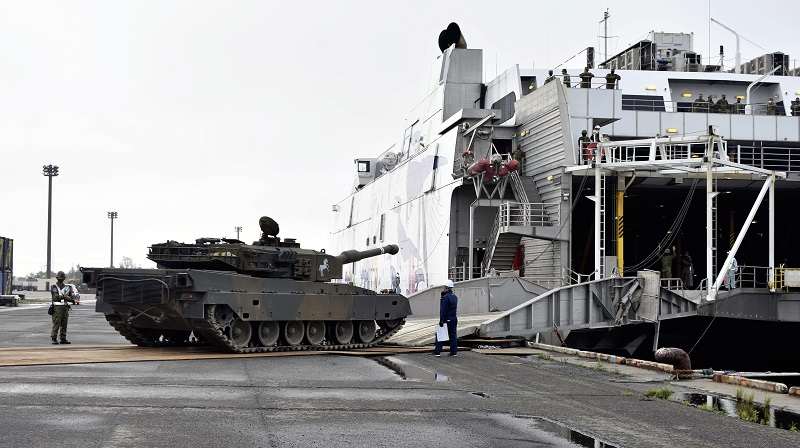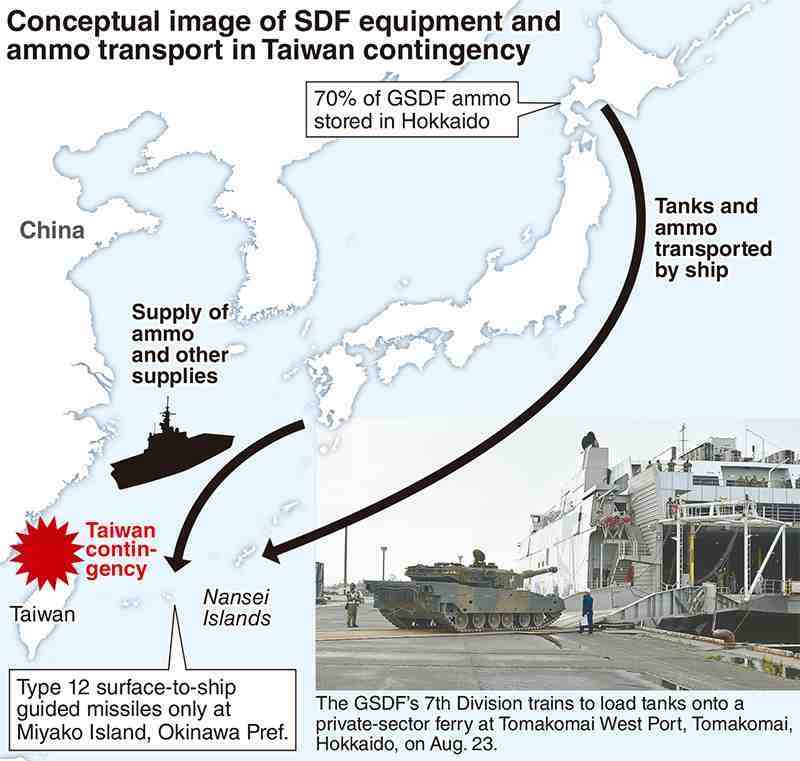Lessons from Ukraine / Budget issues could undermine Japan’s ability to continue fighting

6:00 JST, August 29, 2022
Six months have passed since Russia invaded Ukraine. Since the conflict began, new modes of war and related defense issues have come to light. This series explores possible lessons for Japan.
***
As part of a training exercise in early August, a Ground Self-Defense Force unit fired a Type 12 surface-to-ship guided missile (with a range of 150 kilometers) from a mobile vehicle, hitting a “enemy” ship. U.S. military officials were said to be amazed at the missile’s accuracy.
The Rim of the Pacific (RIMPAC) maritime drill — held off the coast of Hawaii under the auspices of the U.S. Navy — marked the first time for the Maritime Self-Defense Force to participate in an exercise that assumed an “threat to national existence.” The GSDF extended ground-based support.
If such a threat were to occur and a country with close ties to Japan was attacked, the Japanese government could launch a counterattack based on a limited exercise of the right of collective self-defense. The military drill was thus themed around “how to support an ally under armed attack,” with an eye on a possible contingency occurring in Taiwan.
Type 12 missiles would play a key role in the defense of the Japan’s remote islands in the event of a Taiwan emergency, but the missiles are expensive — costing over ¥100 million per missile — and stock is limited. GSDF units do not fire these missiles often; only one was used during the recent RIMPAC exercise.

Japan’s defense spending has been kept to within 1% of the country’s gross domestic product, and the budget has been allocated preferentially to front-line equipment such as fighter jets and destroyers. This means that ammunition — including missiles — and equipment repairs have been put on the back burner. If serious trouble unfolded in Taiwan, Japan would be unable to fight for a prolonged period due to a lack of ammunition. A senior official of the Defense Ministry said, “If we were to fire [at an enemy] head-on, as [the two sides have been doing] in Ukraine, our ammo wouldn’t last more than 10 days.”
In the initial stages of a Taiwan emergency, Yonaguni Island, 110 kilometers east of Taiwan, and other outlying islands could be targeted. The only nearby location that the SDF keeps Type 12 missiles is on Miyako Island, Okinawa Prefecture, to counter a possible threat from Chinese naval vessels. However, it would take time for U.S. reinforcements to arrive from Hawaii, and ammunition is limited at U.S. bases. A former senior U.S. Defense Department official said “current ammunition supplies fall far short” of requirements to counter the Chinese military.
The Japan spends a little over ¥200 billion each year on ammunition, less than one-tenth the U.S. budget. Tokyo plans to significantly boost this figure in its budget proposal for next year, but it is unclear whether the plan will be actioned.
In late June, a senior Defense Ministry official negotiated directly with an ammunition manufacturer, asking it to boost production. However, a company official reportedly replied, “We can’t increase output because there’s no guarantee of long-term orders.”
The Self-Defense Forces have approximately 1,400 ammo depots nationwide, but many are small and there is a general shortage of storage space. The construction of new depots is often difficult due to opposition from local residents. Manufacturers can also be hesitant over concerns that increased production could cause depot-storage issues, leading to a drop in orders.
In a Taiwan-related contingency, tanks, ammunition, supplies and other equipment would have to be moved quickly to the Nansei Islands. As part of a training exercise to prepare for the transfer of materiel to the islands, two state-of-the-art Type 10 tanks, self-propelled ammunition guns and other heavy equipment belonging to the Hokkaio-based GSDF 7th Division were loaded onto a private-sector ferry at Tomakomai West Port on Aug. 23. Approximately 70% of GSDF ammunition is stored in Hokkaido, and the 7th Division — a “mobile division” — is assigned the task of moving and transporting ammunition across the country.
Civilian ferries during the drill because the MSDF only has three transport vessels capable of moving tanks and other heavy equipment. Although the Defense Ministry has a contract to use civilian ferries in the event of an emergency, the crews comprise civilians, who may be reticent to work if fighting escalates.
Katsutoshi Kawano, former head of the Joint Chiefs of Staff, said: “As an island nation, Japan must be able to hold its own until it receives support from its allies. The top priority is to improve the capability to continue fighting by increasing defense spendin
Low defense outlays
The Japanese government plans to hike defense spending from the next fiscal year. The defense budget for fiscal 2022 is ¥5.4 trillion, which is equivalent to 0.96% of the nation’s GDP. This is a low when compared with other major countries. The North Atlantic Treaty Organization requires member countries to spend at least 2% of their GDPs.
However, Japan’s defense spending differs from that of NATO’s: Using the “NATO standard” — which would cover expenses for Japan’s Coast Guard and U.N. peacekeeping operations — defense expenditure would run to approximately ¥6.9 trillion, representing 1.24% of the GDP in fiscal 2021, including supplemental budgets.
The Liberal Democratic Party has stated that the country should “achieve the necessary budget level within five years.” A government official opined: “It’s difficult to achieve 2% [of GDP] under the current framework, so adopting the NATO standard could be an idea to consider.”
To further raise the level, it will be also be necessary to address research and development expenditures.
The U.S. defense budget for fiscal 2023 is $813 billion (about ¥111 trillion), with R&D costs of $130 billion (about ¥18 trillion) accounting for 16% of the total. The Defense Advanced Research Projects Agency, the Pentagon’s research arm, is pushing the military application of advanced civilian technologies.
In contrast, Japan’s R&D fiscal 2022 spending is only about ¥164.4 billion, or 3% of the total defense outlay. The government as a whole spent ¥4,219 billion, with the Education, Culture, Sports, Science and Technology Ministry accounting for 49% of the total, followed by the Economy, Trade and Industry Ministry with 15%. The Defense Ministry ranked sixth, accounting for just 4% of spending.
Bureaucratic sectionalism makes it almost impossible for other ministries’ R&D outlays to be used for the defense sector. For Japan to keep step internationally in such cutting-edge technologies as artificial intelligence and the electromagnetic spectrum, it is necessary to consider reorganizing the budget compilation.





